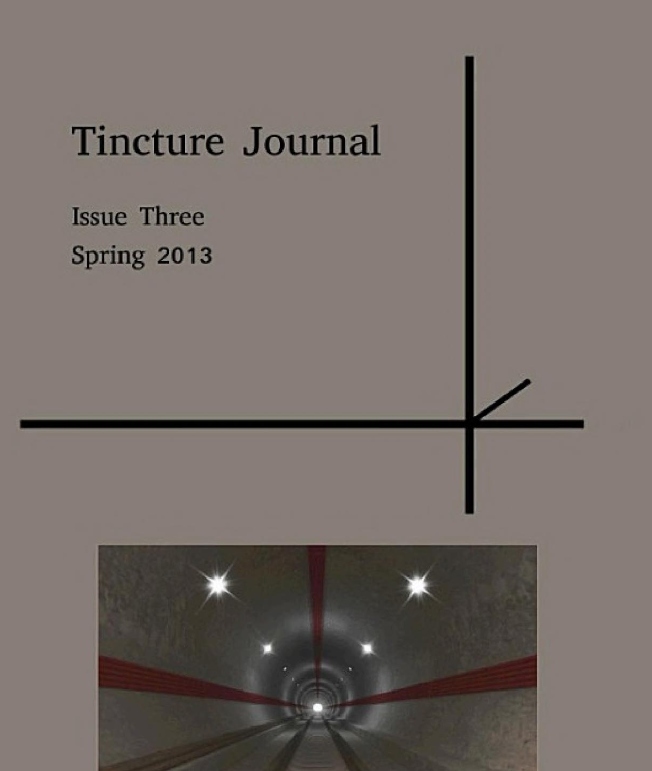Tincture: Issue 3

This is a lit journal review from Veronica Sullivan.
Tincture Journal, Issue 3
Edited by Daniel Young
86 pages
$8
Tincture is a newish ePub-only literary journal, publishing “quality writing from Australia and the world”. As journals go, its submissions policy is as wide open as you could imagine: no themes or word limits, with a constantly rolling call-out for submissions. Such permissive criteria can be dangerous – quality and cohesion can be jettisoned with the excitement of showcasing as many ideas as possible – but Tincture largely avoids these pitfalls, and gathers unique and surprising work from relatively unknown writers.
Some of the pieces in Tincture are genuinely funny and imbued with sharp irony. Matt Smith’s ‘Enjoy the Silence’ wryly describes the collision between a hermetic monk and the world of Instagram and Reddit. Ron Barton’s “A Tale with a Twist” lays bare the monstrous horror of a crowded commute with evident relish:
“Among them the Zombies lounged in their school uniforms. They chewed gum, communicated in monosyllabic grunts and, to The Man at least, appeared in dire need of brains. He sat quietly so as not to alert the Zombies to his presence and prayed to the absence of God that they wouldn’t get off at his station.”
There is also graceful, poignant writing. Alinta Krauth deftly sketches character in a single line: “She would spend most of her days finding spiders’ webs to walk through, and she refused to wash them off.” These sorts of small, keenly observed insights reward the attentive reader. Joanna Wolthuizen’s ‘Blink’ is a staccato sensory monologue, a self-directed harangue comprised of beautifully sad outbursts of longing and doubt:
“There was enough light to draw: a candle to the right and one over there. And another, just beside. I wanted to sink the candle, to see the light underwater. I looked at the water. It looked something like glass and silk. I wanted to feel the light ripple under the glass. The surface of the water, I mean. It wouldn’t have looked pretty though.”
The lynchpin of the issue is Suzanne Moore’s 15,000 word story ‘The Station’, produced as part of Moore’s Honours thesis. It’s a bold move for a literary journal to feature one piece of such substantial length. Though the story occasionally bows, it never buckles beneath the weight of this pressure, and ultimately impresses as a deeply resonant and affecting read.
‘The Station’ is dreamlike and mesmerising, set in a cavernous, crowded train station and laden with shadowy symbolism. There are echoes of the confusion and bureaucratic madness of Kafka; of Jose Saramago’s dystopic parable Blindness; of the limbo-like setting of J.M. Coetzee’s The Childhood of Jesus; and of a breakdown in societal mores masquerading as tightly regimented order, similar to that depicted by Shirley Jackson in her perfect short story ‘The Lottery’. For all these comparisons, and despite intermittent narrative patchiness, ‘The Station’ is never derivative but instead resolutely unfamiliar. It’s a disconcerting read, but not an unpleasant one.
Some of Tincture’s prose suffers from unevenness of quality. There are stories which wear their themes too heavily, are overwritten and under-edited, or have abortive, fragmentary narratives rather than whole structures or fully-conceived ideas. The standard and skill of the contributors traverses the spectrum, and filtering through it can feel like panning for fool’s gold. But when Tincture’s writing is good, it is excellent. It contains an abundance of disparate voices, and offers unique ideas – some weird, some wonderful, all original.
The poetry in Tincture is more consistent than the prose. This third issue is the first to have been assembled with the aid of the journal’s new poetry editor, Stuart Barnes, and the influence of a cohesive, focused taste is evident. Though some enduring themes recur – animals, the physicality of the body – the poems are crisp and singular, with vivid imagery and a refusal to conform to poetic conventions. Many of them shun traditional poetic structures, instead opting for loose line breaks and varying rhythms. Sentences trip down the page like they’re stumbling on stairs.
Tincture’s poems are accessible but not easy. It is a pleasure to be pulled along by poems like Cheryl Pearson’s ‘Seals, San Francisco’:
“They could be survivors from the ribs of a wreck.
Or selkies, forced by genetic blip
to return after a time to those wet
pelts and pull them back up over golden hips,
leaving behind for their brooding lovers
only their templates on a cooling sheet.
A faint salt scent in the cotton covers
that the first bitter laundering will delete.”
In his editor’s letter for Issue Three of Tincture Journal, Daniel Young admits that the “dorky” cover design is not the magazine’s strong point. “We’d rather pay writers than designers,” he says with refreshing candour. Judging by the strength and diversity of the writing in this issue, these priorities are reaping creative dividends. Tincture’s editors are daring to do something a little bit different – but, more importantly, so are its contributing writers.
—–
Veronica Sullivan is a writer, bookseller and masters student from Melbourne. She blogs here and tweets here.

